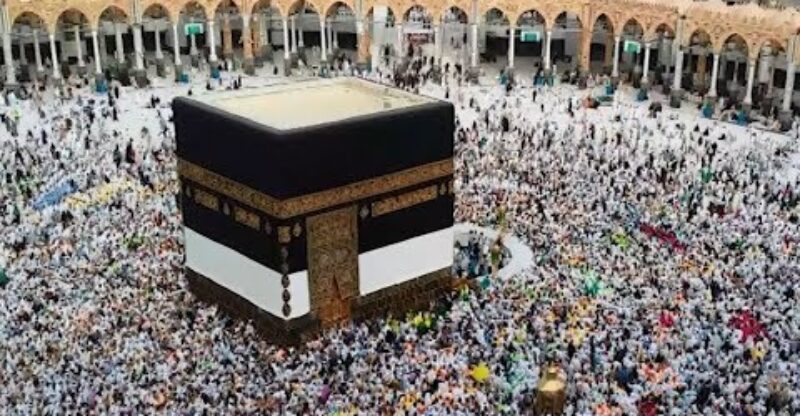HAJJ
Hajj Training Documentary in URDU
What is Hajj?
Hajj or pilgrimage to Mecca is one of the five pillars of Islam. Hajj was made obligatory in the 9th year of Hijra. The Holy Prophet sent off 300 Muslims under the leadership of Hazrat Abubakr Siddique (may Allah be pleased with him) to Mecca so that they could perform Hajj. That was the year when it was banned for the Mushrikeen (those who associate partners with Allah) to enter Kaaba. It was also made unlawful to perform Tawaaf (circling of Kaaba) with a naked body.
The following year, 10th Hijra, the Holy Prophet (peace be upon him) announced ahead of time he himself would perform Hajj that year. He led tens of thousands of Muslims to Hajj that year and demonstrated to Muslims how to perform all the rites and rituals of the Hajj. This Hajj is known in history as Hajjatul Wida? or Farewell Pilgrimage because this proved to be the last Hajj the Holy Prophet (peace be upon him) performed.
On Whom is the performance of Hajj (Pilgrimage to Mecca) incumbent?
The performance of Hajj is incumbent on all Muslims, at least once in a lifetime, if circumstances permit, i.e., if they are in a position both physically and materially to undertake the journey to Mecca and make sufficient provision for their dependents during the period of their absence
How do you define Hajj?
The Pilgrimage to Mecca in the state of Ihram to be adopted at the Miqat strictly carrying out all that it imposes, observing wuqoof at ‘Arafat, performing the tawaf at Ka’ba, etc., in accordance with the prescribed laws is called Hajj
What is ‘Umra?
The visit to Mecca at any time of the year in the state of Ihram to be adopted at Miqat, performing the tawaf round Kaaba in Mecca and accomplishing sa’ee in accordance with the prescribed laws is called ‘Umra. What do you mean by Ihram?
The removal of sewn clothes from the body and wrapping it up in a couple of seamless sheets at the Miqat with the intention of performing Hajj or ‘Umra, and abstaining from all things that are unlawful for those intending to perform Hajj or ‘Umra signifies Ihram
What do you understand by Tawaf?
The performance of seven circuits round the Kaaba (in Mecca) commencing from the Black Stone and having the Ka’ba on one’s left is called Tawaf.
What does the term Sa’ee signify?
Sa’ee signifies the act of marching to and from between the two hills of Safa and Marwa (near Ka’ba) in accordance with the prescribed laws.
What is Wuqoof?
The stay at ‘Arafat, at least for a few minutes, during the time between the declining of the sun from the meridian on the 9th of Zilhijja (the 12th lunar month) and before the dawn of the 10th of Zilhijja is called Wuqoof
What territory does Haram constitute?
The City of Mecca, in which the Ka’ba is situated along with certain defined outlying territory on all its sides, is called Haram
What are Miqats?
The boundary lines which the pilgrims or those who want to perform ‘Umra should not cross without adopting the Ihram are called Miqats.
How many Miqats are there? What are their names and for whom do they indicate the boundary line of Haram?
There are five Miqats in all:-
1- Zul-Hulaifa or Bi’r Ali, which indicates the borderline of Haram for those coming from the side of Medina
2- Zat-al-Iraq serves as Miqat for those coming from the side of Iraq or Mesopotamia
3- Jahfa or Rabigh is the Miqat for those from Syria
4- Quran for those from the side of Najd
5- Yalamlam for those from the direction of Yemen, Pakistan, India, etc.
How should a male pilgrim adopt the Ihram?
When a male pilgrim is about to cross a Miqat, he should perform Ghusl, divest himself of sewn clothes, and wrap up the lower portion of his body in a seamless sheet and cover up the upper part with another one, keeping the head and face bare. The footgear must be such as to keep the central bones of the outer parts of his feet open. He must then offer two Rak’ats of Nafl, and lastly, he must form in his mind the Niyyat and give utterance of his intention as to the purpose of his adopting the Ihram
What is the form of Niyyat for Hajj?
The form of Niyyat for the Hajj is:-
Allahumma inni uridulhajja fayyassirhu liwa taqabbalhu minni, nawaitul-hajja wa ahramtu bihi mukhlisan lillahi ta’ala
i.e., ‘O Allah! I intend to perform the Hajj. Make Thou the same easy for me and accept it from me. I have conceived the Niyyat for Hajj and I have adopted the Iharam sincerely for Allah, the Sublime
What is the form of Niyyat for ‘Umra?
If one wants to perform only ‘Umra he or she should say,
Allahumma inni uridul ‘Umrata fayasshirha li wa taqabbalaha minni, navaitul-‘Umrata wa ahramtu biha mukhlisan lillahi ta’ala
i.e., ‘O Allah! I intend to perform ‘Umra. Make Thou the same easy for me and accept it from me. I have conceived the intention for ‘Umra and have adopted the Ihram for it, sincerely for the sake of Allah, the Sublime.’
What is the Niyyat for performing Hajj and ‘Umra together?
It is:-
Allahumma inni uridulhajja wal ‘Umrata fayassirhuma li wa taqabbalhumma minni, nawaitul Hajja wa ‘Umrata wa ahramtu bihima mukhlisan lillahi ta’ala.
i.e., ‘O Allah! I intend to perform both Hajj and ‘Umra, Make Thou the same essay and accept them from me. I have conceived the intention for both Hajj and ‘Umra and have adopted the Ihram to perform both Hajj and ‘Umra only for the sake of Allah, the Sublime.
What should one do after one has given utterance to one of the appropriate Niyyats?
After one ahs given utterance to one of the Niyyats, one should say aloud (these words should be perfectly committed to memory as one will have to recite them again and again, sitting , standing, mounting and dismounting):
Labbaik Allahumma Labbaik; labbaika la sharika laka labbaik; innal-hamda wan ni’-mata laka wal mulka la sharika lak.
i.e., ‘Here I am at Thy service. O Allah! Here I am at Thy service; Here I am at Thy service; There is no partner unto Thee; Here I am at Thy service; To Thee the glory, the riches and sovereignty of the world. There is no partner to Thee’.
What things become unlawful for those adopting the Ihram ?
The things that become unlawful for those adopting the Ihram and remain as such till the object for which the Ihram has been adopted is accomplished are:
1- Hunting or aiding and abetting it.
2- Sexual intercourse or its preliminaries.
3- Cropping or shaving of hair or paring of nails.
4- Covering of head or face in any way whatsoever
5-Use of gloves or socks
6- Wearing of any kinds of sewn clothes or underwear
7-Using any perfume or perfumed preparation.
8- Deliberated smelling of perfume or applying it to any part of the body or the sheets covering it, or even keeping it in any manner on one’s person. (If any aroma of perfumes applied before the conception of Niyyat remains, it does not matter, for its is permissible).
9- Killing or even dislodging and throwing away lice if they happen to find their way on one’s person or the sheets covering it.
What is the difference between the adoption of Ihram by men and women?
The points of difference between the adoption of Ihram by men and women are:
1- That a woman can wear sewn clothes.
2- She can cover her head (as a matter of fact she should cover her head in the presence of all men excepting her husband, as also whilst offering prayers).
3- She should not put on a veil in such a manner that the fabric may touch her face
4- She can put on socks or gloves.
5- All the other things which are unlawful for a man are Laos unlawful for her.
Note:- A woman should not utter “labbaik”, etc., aloud but should say the same in a subdued voice.
How is the Tawaf performed ?
The points to be observed in the performance of Tawaf are:
1- The performer of Tawaf should stand towards that corner of the Ka’ba where the black stone is embedded in its wall in such a manner as to have it on one’s and then give utterance to the Niyyat or performing it in the words:
Allahumma inni uridu tawafa baitikalmuhar-rami fayassirhu li wa taqabbalhu minni.
i.e., ‘O Allah! I intend to perform the tawaf of Thy consecrated premises. Make Thou the same easy for me and accept it from me’
2- Then facing the Black Stone and raising the hands with palm onwards, one should say:
Bismillahi walhamdu lillahi wallahu Akbar wassalatu was-salamu ‘ala Rasoolillah.
i.e., “I begin in the name of Allah, and all Praise is due to Allah and Allah is Most Great, and peace and blessings be on Allah’s Apostle.”
3- If possible one should approach the Black stone and give it a kiss, but if it be not feasible, then one should give it a flying kiss, and recite the Du’a:- (
a) Allahummaghfirli zunoobi wa tahhir li qalbi wa ashrah li sadri wa yassir li amri wa ‘afini fi man ‘afait.
i.e., ‘O Allah! forgive me my sins and purify my heard and expand my chest (i.e., give me spiritual illuminaiton) and make my task easy and preserve me among those Thou has preserved.’
(b) Then one should proceed towards the Gate of Ka’ba saying:-
Allahumma imanam bika wa tasdiqan bikitabika wa wafa’an bi-‘ahdik wattiba’an li sunnati nabiyyika Muhammadun, sallallahu ta’ala ‘alaihi wa sallama, wa ashhadu an la ilaha ill-Allahu wahda-hu la sharika lahu wa ashhadu anna Muhammadan ‘abduhu wa rasooluhu, amantu billahi wa kafartu bil-jibti wattaghoot.
i.e., ‘Oh Allah! (I am performing this) with complete Faith in Thee and Belief in the Truth of Thy Book and in the fulfilmient of my pledge to Thee, and in the wake of the sunnat of Thy Prophet Muhammad, may peace and blessings of Allah be upon him. I bear witness to the fact that there in no God but Allah and that Muhammad is His Prophet. I have faith in Allah and do not believe in evil spirits and ghosts.
Note:-
4- the act of kissing the Black stone and reciting du’a is called Istilam.
5- Then, having the Ka’ba on one’s left, one should take a complete round of it, remembering Allah all the while or reciting Du’a (a and b of 3) in the same way as before. This completes one circuit.
Note:-
6- One may kiss, if possible the South-West corner of Ka’ba which is called Rukn-i Yamani.
7- One should perform seven rounds in the manner described. After the completion of seven rounds one should stand near the gate of Ka’ba and pray for Allah’s blessings. Lastly, one should offer two Rak’ats of Sunnatut-tawaf, preferably near Maqam-i-Ibrahim, a spot just near Ka’ba.
What acts are culpable during the performance of tawaf?
The acts that are culpable during the performance of tawaf are:
1- Being without ablution.
2- Uncovering of more than a quarter part of any limb of the body which must be kept covered
3- Performing of the tawaf either by supporting oneself on someone’s shoulder or mounted, without any cogent reason
4- Performing the tawaf in a sitting posture without any cogent reason
5- Performing the tawaf with the Ka’ba on one’s right
6- Performing the tawaf round The Ka’ba exclusive of Hatim (Hatim is the name for the portion of land in the North of Ka’ba which was left out when the Ka’ba was rebuilt
7- Performing a lesser number of circuits than seven
What acts are not permissible during the performance of Tawaf?
Such acts are:
1- Discussion of mundane matters
2- The performance of Tawaf in an impure garb
3- The disregard of Ramal signifies marching briskly, moving the shoulders with chest out, like the gait of a soldier, in the first three circuits of the Tawaf of ‘Umra.
4- The disregard of Iztiba’a, which denotes the act of removing the sheet from the right shoulder and passing it under the right armpit to place it on the left shoulder, thus keeping bare the right arm in the Tawaf of ‘Umra.
5- Omission of Istilam.
6- Pauses between the circuits of Tawaf (Of course if the Wudu is made void or a congregation of an Obligatory Prayer is ready, one may discontinue the circuits to perform the Wudu or to join the congregation and complete them later on).
7- The failure to offer two Rak’ats of Nafl after the completion of each Tawaf, i.e., seven circuits of the Ka’ba (if the time be, however, one when it is not permissible to offer the prayers, one is allowed to defer the same till the completion of the second Tawaf).
How should the Sa’ee be performed?
In order to perform the Sa’ee one should betake himself to Safa and after arriving there recite:-
1- Abda’u bima bada’ Allahu bihi, innas-Safa wal Marwata min sha-‘a-‘irillahi, faman hajj-al-baita awi’tamara fala junaha’alaihi anyyat-tawwafa bihima wa man tatawwa’a khairan fa inn-Allah Shakirun ‘Aleem
i.e., ‘I commence with that with which Allah commenced. Surely Safa and Marwa are prominent symbols of Allah. Hence there is no blame on one who performs the Hajj of the House (of God) or ‘Umra if he (or she) marches to and from between them (Safa and Marwa), and one who does good of one’s own accord, verily Allah is Responsive, Aware’.
2- Then, raising the hands to the shoulders, one must say:
(a) Allahu Akbar (thrice), and
(b) La ilaha illallahu wallahu Akbar wa lillahilhamd.
3- Then one should give utterance to his or her Niyyat in the words:-
Allahumma inni uridus-Sa’ya bainas-Safa wal Marwati fayassirhu li wa taqabbalhu minni.
i.e., ‘O Allah! I intend to perform the Sa’ee between Safa and Marwa; make Thou the same easy form me and accept it from me.’
4- Then one should march towards Marwa, reciting Du’as all the way.
5- When one reaches a green spot one should march quickly till one reaches another green spot, and in between those spots one should recite the following Du’a:-
Rabbighfir warham wa tajawaz ‘mma ta’lam wa ta’lamu ma la na’-lam innaka antal-A’az-zul-akram; Allahum-maj’alhu hajjammab-rooran, wa sa’yam-mashkooran, wa zam bammaghfoora.
i.e., ‘O Allah! Forgive me and have mercy upon me and pass off (my sins) of which Thou are aware, and Thou knowest that of which we have no knowledge; verily thou art the Most Honorable, and Most Exalted. O Allah! make it (for me) a Hajj that is acceptable (to Thee) and an effort that is granted and (a means of) forgiveness of sin
6- Arriving at Marwa one should face Ka’ba and pray for blessings (this complete one turn).
7- Then one must go back to Safa in the same manner, marching quickly between the two green spots, reciting Du’as, etc., and when Safa is reached one must again face the Ka’ba and pray for blessing (this will complete the second turn).
8- One must take seven such turns, and at the accomplishment of the seventh, when one arrives at Marwa and offers up the prayer one is said to have accomplished the Sa’ee.
Can you describe the performance of Hajj?
Yes, in order to perform Hajj:-
1- As soon as a pilgrim approaches the boundary line of the Holy Land, i.e., the Miqat, he or she enters the state of Ihram with all its accomplishments.
2- On reaching Mecca the pilgrim goes to the Grand Mosque round the Ka’ba and then performs an optional tawaf, called Tawaf-ul-Qudoom.
3- On the 8th day of Zilhijja the pilgrim goes to Mina, before the time of Salatuz-Zuhr, a town three miles from Mecca, and spends there the rest of the day and the whole night of the 9th of Zilhijja
4- After the early morning prayer of the 9th Zilhijja, the pilgrim proceeds to Arafat, a place about seven miles from Mecca, and stops anywhere in the Mauqafs (staying places) in the area surrounding the Jabal-i-Rahmat, (i.e., the Hill of Mercy) in the remembrance of Allah.
5- Just after the sunset of the 9th of Zilhijja the pilgrim leaves the Mauqaf without offering Salatul-Maghrib, and proceeds to Muzdalifa, a place between Mina and Arafat, where he or she offers Maghrib and Isha Prayers.
6- The pilgrim then proceeds from Muzadalifa after the early morning prayers of the 10th of Zilhijja (picking at least 49 pebbles from there) and comes to Mina.
7- The pilgrim then takes up seven pebbles, and holding each between the index finger and the thumb of the right hand, throws them one by one at the pillar called Jamra-tul-Uqubah on the same day, i.e., the 10th Zilhijja
8- The pilgrim then, if he or she can afford, makes a sacrifice of a goat or a sheep or joins six others in the sacrifice of a camel or a bull, and shaves off preferably the whole head or at least a quarter head, or crop the hair equally all over the head, if the pilgrim be male, and in the case of a female pilgrim, she should cut off at least an inch of her hair.
9- The pilgrim then leaves off the state of Ihram and proceeds to Mecca on the same day and performs the Tawaf, called Tawaf-ul-Ifada, after which the pilgrim offers two Rak’ats of Sunnat prayers.
10- The pilgrim then accomplishes the Sa’ee.
11- The pilgrim then returns to Mina and spends there the night of the 11th of Zilhijja
12- After the midday of the 11th and the 12th of Ziljijja the pilgrim approaches in the order mentioned, the pillars called Jamra-tul-Oola, Jamratul-Wusta and Jamratul-Uqubah, and throws seven pebbles against each of them, reciting at each throw: “Bismillahi Allahu Akbar”. If a pilgrim stays on the 13th of Zilhijja as well, he or she throws seven pebbles at the pillars as on the two previous days.
13- The pilgrim then returns to Mecca after the Salatuz-Zuhr on the 12th of Zilhijja. Before leaving Mecca for one’s own country, the pilgrim, performs a departing tawaf, called Tawaf-ul-Wida’.
Notes:-
1-During one’s stay at Mecca one may perform as may tawafs as one can, for the performance of tawafs is the best form of worship during that period.
2- One can also perform ‘Umra as may times as one likes by going out of Mecca to Tan’eem (a place about three miles form Mecca) and adopting the Ihram there, return to Mecca and perform the tawaf and sa’ee as is usual for ‘Umra.
How does one perform ‘Umra?
In order to perform ‘Umra one should in the first instance:
1- Adopt the Ihram at the Miqat in accordance with the prescribed laws.
2- After preceding to Mecca one should betake himself or herself to Ka’ba and affecting the Iztaiba’a, one should form and given utterance to the Niyyat for Tawaf and commence the performance of the same.
3- One should take care to perform the first three circuits in the style of Ramal
Note:- A woman is, however, exempt both from Iztiba’a and Ramal.
4- After the completion of the three circuits, the remaining four are performed in the normal manner and one should then offer Rak’ats of Sunna-tut-Tawaf.
5- One should then preferably proceed to the well of Zamzam and drink a little water.
6- From thence, betaking oneself to Safa, one should accomplish the Sa’ee according to the prescribed laws.
Note:-
The performance of ‘Umra is completed after the accomplishment of the Sa’ee. Now if one wants to perform the Hajj in the very Ihram, one may maintain the same; but if one does not want to do so, one should shave off at least a quarter or preferably the whole heard or crop the hair all over the head. The pilgrim is then free from all the impositions and restrictions that the state of Ihram imposes.
Can Hajj and ‘Umra be performed in the same state of Ihram?
Yes, Hajj and ‘Umra can be performed in the same state of Ihram, in which case the pilgrim should not leave off the state of Ihram after the performance of ‘Umra till the completion of Hajj
What is Qiran?
When the Hajj and ‘Umra is performed in the same state of Ihram, it is called Qiran
What is Tamattu?
When the ‘Umra is performed in the month of Hajj and then Ihram is removed and re-donned on the 7th of Zilhijja at Mecca for the second time for Hajj, ita is called Tamattu’.
Note:-
One who performs Qiran or Tamattu’ is bound to sacrifice a goat or sheep or join six others in the sacrifice of a camel or a bull, or observe ten fasts, three before Hajj and seven after its performance.
What is Ifrad?
If one performs Hajj alone and not ‘Umra, it is called Ifrad.
Note:-
The sacrifice of an animal is not obligatory on one performing the Hajj alone, i.e., Ifrad.
If anyone of the essential observances in connection with Ihram, Tawaf or Sa’ee are transgressed, one is liable for penalties in the shape of either sacrificing a goat or a sheep or distributing alms.
What should a pilgrim do after performing Hajj?
It is very commendable for a pilgrim to pay a visit to the Mausoleum of the Holy Prophet at Medina, and standing there in a reverential posture facing the tomb of the Great Prophet, to say:-
Assalamu ‘alaika ayyuhan-Nabiyyu wa rahmatullahi wa baraktahu, Assalamu ‘alaika ya Rasoolallah! Assalamu ‘alaika ya Nabi-Allah! Assalamu ‘alaika ya Habib Allah Assalamu ‘alaika ya khaira-khalqillah! Assalamu ‘alaika ya Shafi-al-muznibeen! Assalmu ‘alaika wa ‘ala alika wa as-habik wa ummatik ajma’een
i.e., ‘Peace be on you, O Prophet (of Allah)! and His mercy and His blessings. Peace be on you, O Apostle of Allah! Peace be on you O Prophet of Allah! Peace be upon you, O Beloved of Allah! Peace be on you, O Best in the (whole) Creation of Allah! Peace be on you, O Pleader for the sinners (before Allah!) Peace be on you and your descendants and your companions and all your followers.







